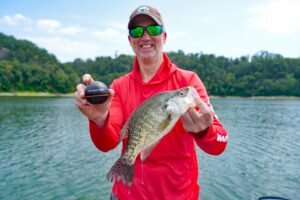Split screen imaging with traditional sonar on one side and mapping on the other. Sonar screen capture during
the summer month with a thermocline starting at 20 feet and balls of shad near the surface. (Photo by Brad Wiegmann)
Smart, Castable Fishfinders
by Brad Wiegmann

Interfacing between smartphones and marine electronic units isn’t anything new. Most electronic companies allow for linking a smartphone and the electronics they manufacture.
When you think about it, however, your smartphone is really only a display monitor with basic touch controls. Now a company called Deeper Sonar is producing a castable transducer connecting to your smartphone to produce sonar imaging of structure, vegetation, fish and mapping.
Unlike portable, self contained ice fishing sonar models that are available from Garmin, Humminbird, Lowrance, MarCum and others, Deeper Sonar allows anglers to cast out a transducer away from where they are standing. It automatically sits upright and sends sonar images to your phone.
Crappie anglers using castable smart sonar are typically standing onshore, a dock, in a kayak or boat without electronics. By using an angler’s existing smartphone and downloading the app, it turns your smartphone or tablet onto a sonar display. The smartphone controls what and how an angler sees sonar and mapping imaging.
Before fishing an angler has to setup the smartphone to personalize the sonar imagining and information that will appear on the screen. It starts with what type of fishing an angler is doing. You have to pick from onshore, boat, ice fishing, or scan without utilizing GPS. Next an angler can select from basic display that shows fish as icons or RAW with detailed imagery similar to what you normally see on boat units. Angler’s can split screen the mapping and sonar imaging along with instant depth and temperature readings.

Beam angle can be selected on the app depending on the model. Deeper Sonar has 3 frequencies of CHIRP including narrow CHIRP 675kHz (cone angle 7 degrees), Medium CHIRP 240kHz (cone angle 20 degrees) and Wide CHIRP 100kHz (cone angle 47 degrees). Deeper Pro+ has the same cone angles, but not in CHIRP. Deeper Pro has only a wide 55 degree and narrow 15-degree cone angle. Once a beam angle is selected an angler can adjust the display sensitivity according to the turbidity in the water.
Sonar scans and bathymetric mapping can be created by anglers in a kayak or boat, but crappie anglers can simply cast out the transducer tether to a line from the bank or dock and slowly reel in to display the imaging. Your smartphone can save scan history files allowing you to go back and review mapping and sonar imaging. These files can be saved to the Cloud or on the smart device connected to the transducer.
Castable smart sonar is perfect for crappie anglers fishing ponds from the bank or a dock. The castable transducer is about the size of a baseball and has a built-in rechargeable battery. The connection range is less than 400 feet, but that’s plenty for most crappie ponds.
From Springdale, Arkansas, Brad Wiegmann is a professional photographer, videographer and outdoor writer published in dozens of print and electronic media outlets all across the nation. Every month Wiegmann will be providing CatfishNOW readers with the latest and greatest information on the ever-changing world of fishing electronics. He is also a well-known guide, podcaster and social media influencer. Learn more about Wiegmann and his lengthy experience and expertise at BradWiegmann.com.


